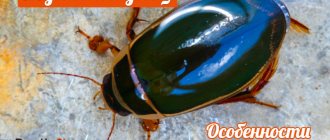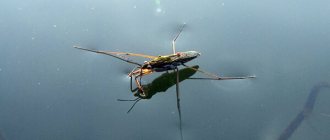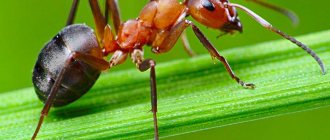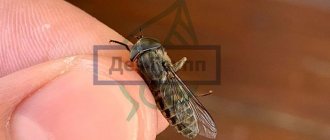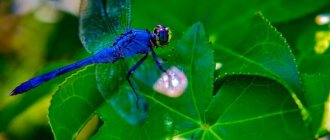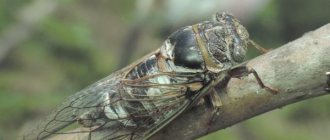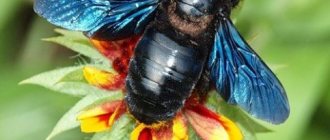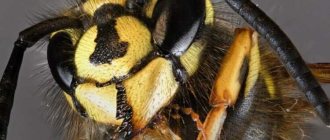How do insects overwinter?
Insects spend the cold season in different ways. Some, like birds, fly south. This is what some species of butterflies and dragonflies do, covering significant distances together with birds and rising to incredible heights (over 5 km).
Read also: Actovegin during pregnancy
Others fall into numbness and hibernation. They climb deep into the earth, hide under the roots of plants, under fallen leaves and trees, stop consuming food and lose mobility. Ants overwinter on the lower floors of the anthill, often located at a depth of about 1 meter.
Naturally, not all species overwinter; representatives of many simply do not survive winter: their life is so short that they are not even aware of the cold.
In the spring, the suspended animation into which the surviving insects fell ceases, and butterflies, beetles, and dragonflies are born along with the first rays of the spring sun.
Symbol in mythology
Among the ancient Egyptians, the scarab, repeating the path of the Sun from east to west, was revered as a symbol of the creator of the world and people - the god Khepri. The deity was depicted as a man with the head of a scarab. In Egyptian mythology, black beetles were considered sacred insects. They symbolized the creative power and warmth of the heavenly body, rebirth in life after death.
Egyptians still treat scarabs with respect, and all the stories about beetles eating people are fictions that contradict real facts. It has been scientifically proven that scarabs are not carnivorous insects. They are unable to eat the flesh of humans or animals.
Fighting the rhinoceros beetle
The rhinoceros beetle is listed in the Red Book and is therefore considered an endangered species. Despite this, many gardeners try to get rid of its larvae, which are not averse to feasting on the future harvest. In this case, humane methods are more suitable to combat this insect. It is enough to catch adult beetles so that they cannot lay eggs. To do this, you can use different types of traps.
Chemicals
It is not recommended to use insecticides against rhinoceros beetles, but if conditions require it, you can use:
Kinds
Entomologists consider the Sacred Scarab beetle to be the only species of beetle, but more than 100 species of similar insects have been differentiated, classified into a separate family of scarabs. The most common of them:
— Scarabaeus (Ateuchetus) armeniacus Menetries;
— Scarabaeus (Ateuchetus) cicatricosus;
— Scarabaeus (Ateuchetus) variolosus Fabricius;
— Scarabaeus (Scarabaeus) winkleri Stolfa.
Besides the Sacred, the most studied representative of scarabs is Typhon, its size is more modest (up to 3 mm), and its color is more like dark brown than black. Basically, all types of beetles differ only in shades and size, and are divided depending on their habitat, and therefore have been little studied - it is generally accepted that they have no physiological differences, and their lifestyle is identical.
Prevalence
Hercules belongs to the lamellar family, the genus Duplyaki. These are the largest representatives of the genus (in general, their number is about 300), which “bear” outgrowths on themselves. The beetle's closest relatives are the rhinoceros beetle, the elephant beetle, and the scarab.
Hercules is native to South America. He also lives in Bolivia, Venezuela, the Caribbean, Ecuador, Peru, Central American regions, Dominican Republic, Mexico, Bolivia, Antilles, Colombia, Brazil, Panama, Guadeloupe. Favorite places are moist forests of subtropical and tropical zones, where a lot of greenery and fruit grow. But sometimes during wet periods they can be found in lowland and mountain forests. They prefer to live on the forest floor. Larvae live in rotting wood, which also serves as food, while adults prefer to live at the base of trees.
Habitat of skorobei
Most species of the scarab genus live in the Afrotropical region, since the hot climate of this area is excellent for these insects. About 20 species can be found in the Palearctic region, in countries such as:
- France;
- Spain;
- Bulgaria;
- Greece;
- Ukraine;
- Kazakhstan;
- Türkiye;
- southern regions of Russia.
It is worth noting that scarab beetles are not found on the mainland of Australia and the entire Western Hemisphere.
Why do dung beetles roll balls?
A black beetle rolling a ball is a nurse beetle, clearing the earth of sewage, at work. This, which has created its fame since ancient times, is the sacred beetle - the scarab. But cleaning the soil is not the beetle's main goal. The main thing is food preparation, since the beetle is very gluttonous and can eat several times the volume of its body in one meal. The beetle is an individualist, preferring to eat alone. But how to deliver food? To do this, he makes a ball so that it can be rolled away from the pile of manure. Even the ancient Egyptians noticed that the path along which the beetle rolls the balls coincides with the movement of the Sun. Moving away from the heap, when the molded ball is delivered to the place of the meal, and the beetle rolls it upside down so as not to go astray, it stops, climbs onto the ball and works like a locator, orienting itself in space. Having found a convenient place, the beetle tears off a hole, hides in it with a ball, blocks the entrance and begins to eat.
It was believed that the ball served as a place for laying eggs, but this was not a dwelling, but only food. To continue the offspring, the female beetle sculpts a dung “pear” into which the egg is laid; it is, at the same time, both a cradle and food for the future beetle. But that's another topic.
Almost more than one hundred and seventy years ago, a similar question was asked by a boy who later devoted his life to studying the life of insects, his name was Jean Henri Fabre, and he also studied the secret of the balls.
The sacred scarab is one of the representatives of dung beetles (family Lamelidae), widespread in North Africa and the countries of Southern and Western Europe.
Scarabs are the real strongmen of the insect world: the balls of dung they roll often reach such a size that they become larger than the beetle itself. It is interesting that the front legs of the scarab seem to be created exclusively for sculpting and rolling balls: they are very strong, dexterous and are never used by the beetle for any other purpose.
What does it look like
The length of the sacred scarab (Scarabaeus sacer) reaches 25–37 mm. The tar-black body is covered with a durable chitinous cover - the exoskeleton (external skeleton). The color acquires a brilliant sheen as it matures. The inner edges of the male's hind legs are covered with golden-red fringe - this is the main difference between the male and female. The head has a serrated clypeus. The pronotum and elytra have a granular texture.
Lifestyle, nutrition and reproduction
The main activity is rolling balls of manure. A fierce fight can break out between several beetles over the finished ball. Most often, scarabs can be seen in the fields, where they gather around piles of dung of ungulates and make balls from it. Then the male and female roll the ball away from the dung heap and bury it in the ground. Most often, these balls serve as food for the beetles, but the female uses some of them to lay eggs.
Natural enemies
Insects that feed on excrement emit a disgusting odor that repels almost anyone who might eat the bugs. Domestic chickens, crows, and omnivorous hedgehogs do not disdain dung beetles. Young, inexperienced foxes may try to eat the dung beetle due to lack of food. To scare away potential enemies, the beetle makes disgusting creaking sounds by rubbing its abdomen and elytra, and also pretends to be dead.
The body of a dung beetle can be parasitized by a special tiny mite, Gamasuscoleoptratorum, which, with its sharp jaws, bites through the insect’s hard shell and attaches itself. One dung beetle can be the host of several mites at once.
Description and features
Dung beetles are representatives of the order Coleoptera, belong to the family Lamelidae and are included in the numerous subfamily of shrews. What a dung beetle looks like depends on a number of factors, in particular the species to which it belongs and its habitat. Thus, the size of the imago can vary from 1 to 7 cm, weight - from 0.75 to 1.5 g. The color can be black, brown, blue, green, yellow.
Moreover, all adult insects have:
- oval or round body shape;
- head directed forward;
- antennae consisting of 11 segments and ending in fan-shaped plates;
- three pairs of legs with serrated tibiae along the outer edge and 2 spurs on the apex;
- abdomen, consisting of 6 sternites, on which 7 spiracles are located;
- mouthparts of the gnawing type.
Also, all beetles have strong, thick, chitinous elytra, under which are leathery wings. But not all drillers can fly; some have completely lost the ability to move through the air.
Interesting! During flight, the elytra of dung beetles practically do not open. This contradicts all the laws of aerodynamics, but does not interfere with the insects themselves. Their flight is so masterly and precise that they can easily catch a moving fly (even many birds cannot do such a trick!)
Interesting
Well, “for a snack” - one very interesting fact. Few people know that dung beetles, which live in the deserts of Africa, have the ability to collect moisture from fog. To achieve this goal, they spread their wings and stand against the wind. Droplets settle on the convex areas, which over time become large and flow directly into the beetles’ mouths. This is how they drink, getting water practically from thin air! Are you weak?
